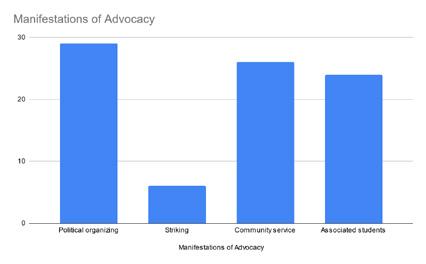
13 minute read
3. Survey
3.1 Methodology
3.1.1 Research design
I prepared a survey with eighteen questions, including a selection of multiple-choice, matrix, and open-response opportunities. The questions were primarily open-ended to allow students to describe, in their own words, their experiences in student advocacy. The purpose of this study was to learn more about how student advocates define and identify their work and attitudes towards advocacy on University of California campuses. The survey was prepared using Qualtrics.
The questions focused on student advocacy experiences, accessibility of resources for students, concerns about challenges and difficulty in student civic engagement, how student advocacy movements are currently manifesting on campuses, and perspectives on student- centered needs and tools.
The survey was launched on November 7, 2022 using the platform Qualtrics to host the survey. The requirements for participants in the survey included being aged eighteen years and over, currently attending one of the University of California campuses as an undergraduate, and having previously or currently participated in advocacy, activism, and/or civic engagement while being an undergraduate at a University of California campus.
The survey received enough responses to achieve a 90% significance level with a 7% margin of error.9
It received Internal Review Board (IRB) approval from UC Davis’s Office of Research (UC Davis IRB ID: 1914104-1).
9 https://www.qualtrics.com/blog/calculating-sample-size/.
Undergraduate Student Advocacy in the University of California System: Research
3.1.2 Survey dissemination
To draw data from students and access student populations, my primary method of survey dissemination was via email. I emailed over 200 UC-affiliated organizations and centers in order to market my survey on November 8, 2022, January 25, 2023, January 30, 2023, and March 1, 2023. UC-affiliated organizations include, but are not limited to: the Associated Student (AS) executive branch accounts, AS legislative branch accounts, AS senator accounts, UC Student Association (UCSA) committees, UCSA campaigns, UCSA officers, racial, ethnic, and cultural interest centers (i.e. “UCI Center for Black Cultures, Resources, & Research”), LGBTQ+ interest centers, educational opportunity centers (i.e. “Transfer Services Center”), and registered student organizations with political purposes (i.e. “Davis College Democrats”), advocacy purposes (i.e. “Our Time To Act (OTTA) United”), community service purposes (i.e. “Women’s Empowerment Coalition” at UCLA), and racial, ethnic, and cultural purposes (“United Afghan Club at UCLA”). I also created an Instagram account entitled “@uc.student. advocacy.research” to promote the survey on social media. I followed 400+ UC-affiliated student organizations.
Students who took the survey were compensated with a $5 Amazon gift card. Additionally, five $100 gift cards were raffled to students who took the survey after the survey had closed. The five students were randomly selected using a random number generator, with the number being the number in which the survey response was received. The survey was open for students to take from November 7, 2022 until March 15, 2023.
3.2 Findings & Key Observations
Predominantly, students that engage in advocacy describe their activities as falling between one of three categories: political organizing, community service, or working within the Associated Student body. From these categories, students specified what their role and advocacy focus was within these activities.
Key Observation 1: student advocacy lives in the campus community.
Survey Results: “Briefly describe your experiences as a student advocate. ”
Survey Results: Forms of political organizing, described
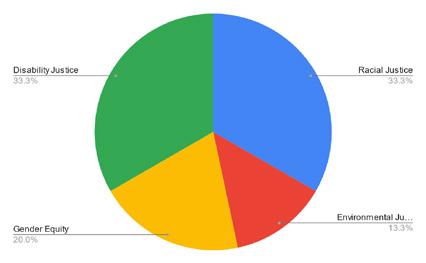
Of the four forms of advocacy that students described in their survey answers, three of the four relate specifically to campus and community. Student government, striking, and community service are all located in the campus community. In the answers that described their experiences related to striking, all students who mentioned striking as their experience in advocacy described participating and supporting the Fall 2022 graduate student strike; thus, this work was specifically related to the campus community. Similarly, advocacy categorized as “community service” referred specifically to work in the campus or local (surrounding campus) community. Subsequently, the majority of advocacy work described—(65.9%)—lives on UC campuses and in the campus community.10
Key Observation 2: Challenges in student advocacy seem to primarily emerge from interpersonal conflict and issues with collaboration, rather than from the advocacy work itself.
Students also broadly defined the challenges they experienced, with a significant number of survey participants noting issues pertaining to working with others in the university. The three top issues that survey participants identified were: maintaining student retention and involvement, working
10 Political organizing, too, can occur on campus. However, since it cannot be identified as solely existing on campus and in the campus community, it has been excluded from this calculation.
Undergraduate Student Advocacy in the University of California System: Research with other students, and working within the bureaucracy at a UC campus. The primary challenges that emerged seem to result from interpersonal conflict and issues with collaboration. Therefore, it appears that students found leadership, community organizing, recruitment, and other organizational aspects of advocacy more challenging than the issues that pertained to the work of advocacy itself.
Students did note that there were challenges experienced that pertained to advocacy work; students stated that learning how to advocate and finding a balance between advocacy work and life were additional issues encountered. Additionally, over a quarter of student advocates that participated in the survey identified that their identity and demographic background hindered their advocacy efforts. Students, in addition to naming challenges regarding organizational aspects of advocacy, also identified the process of learning how to become an effective advocate as a challenge.
Key Observation 3: Advocates have a problem relating the importance of their advocacy to others, which results in lack of awareness, retention, and involvement.
When asked why students do not join advocacy efforts, the majority of students stated that a lack of awareness prevented students from participating in advocacy activities. Financial constraints on students, limited funding and resources for advocacy groups, and student busyness and availability were similarly mentioned as potential reasons.
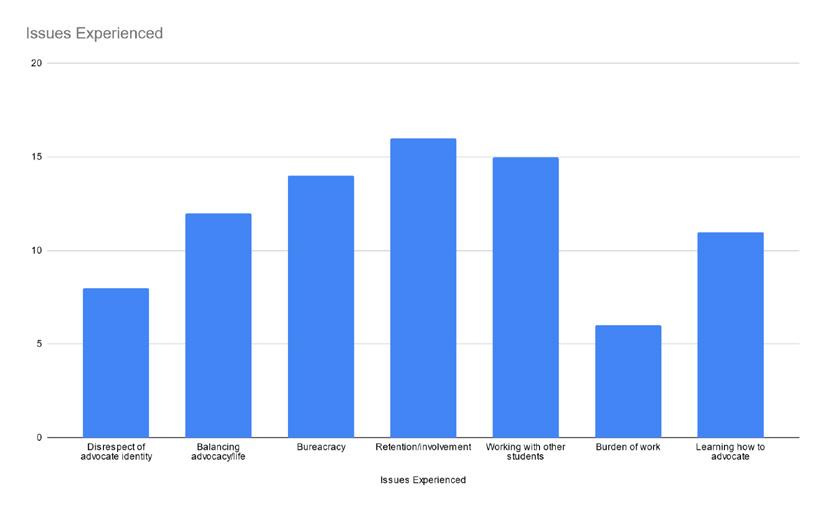
Overwhelmingly, students identified a lack of awareness and interest as a barrier that they have faced in their own work; additionally, time commitments to advocacy have also challenged student participation. Notably, despite retention, involvement, and awareness being a challenge and barrier to advocacy, not all advocates engage in recruitment. Those that do engage in recruitment primarily rely on their network (word-of-mouth) and social media to reach other students through recruitment initiatives.
If retention and awareness are issues, as identified by advocates, relying primarily on advocates’ networks and social media appear to be ineffective ways of promoting advocacy work and circulating information. Thus, I recommend student advocates develop media strategies that incorporate more forms of advertising than just those two forms. Student advocates also identified lack of awareness as a significant barrier that prevents students from participating in advocacy; thus, student advocates must be able to effectively share information about their advocacy and pitch their work. In sharing information to a wider audience, advocates should also be able to explain why this advocacy matters and why students should become involved in or be aware of this advocacy.
Key Observation 4: Students want support from their peers and from administrators.
Students have noted feeling most supported by fellow undergraduates and non-teaching faculty and staff. They noted feeling least supported by administrators. However, when considering who could be most helpful in supporting their advocacy efforts, students, again, identified their fellow undergraduate student peers as the most helpful, but indicated that administrators were the second most helpful population in potentially providing assistance on advocacy efforts.
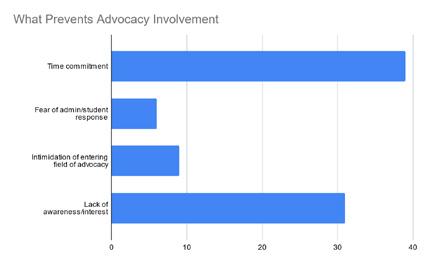
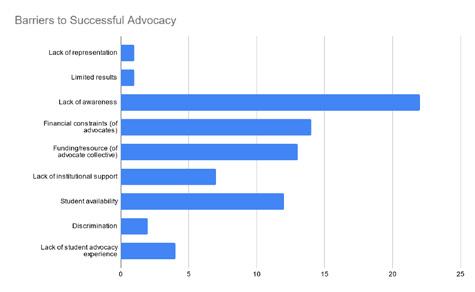
Undergraduate Student Advocacy in the University of California System: Research
Survey Results: “On a scale from 1-10, with 1 being not at all and 10 being extremely, how supported do you feel in your advocacy efforts by the following populations on your campus?”
Survey Response: “Which populations do you think can assist you the most in your advocacy efforts with their support on your campus? Select all that apply.”
The biggest gap from perceived support for student advocates and desired support for student advocates is in the category of “administrators”. This suggests that students want to work with administrators and would be willing to engage with administrators on advocacy projects.
However, student advocates do not feel that they have the support to do so currently. Students also feel most supported and desire support the most from their undergraduate peers. Thus, in spite of the interpersonal and collaboration challenges identified in Key Observation 2, students view their peers as effective advocates and desire to work with them.
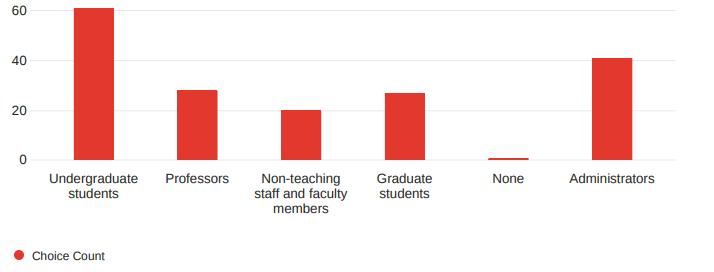
Key Observation 5: Resources pertaining to advocacy education, students’ rights, developing advocacy plans, and finding community solidarity are highly desired.
Finally, when students were asked what resources they would want available to them, the following items were requested:
⚫ “Marketing” resources
⚫ “Resource booklet for common student advocacy resources”
⚫ “How to develop networking connections” or develop a network
⚫ “Resources to get started and how to get heard”
⚫ “A planner/agenda”
⚫ “Guide to increasing outreach”
⚫ “Access to guidance”
⚫ “First Amendment education”
⚫ “Resources to reach out to people”
⚫ “Planning advice”
⚫ “Budgeting options”
⚫ “Simple/easy-to- digest educational materials about what advocacy is…[and] how to do it”
⚫ “Field training”
⚫ “Stories of change”
⚫ “Student rights as advocates”
⚫ “List of…UC administrators”
⚫ “How to advocate for yourself”
⚫ “How to find community”
⚫ “Planners”
⚫ “Testimonials from student leaders”
⚫ “How to balance advocacy with schoolwork and other responsibilities”
⚫ “Leadership framework”
Among these requests, the recurring requests pertain to advocacy education (“Resources to get started and how to get heard,” “Leadership framework,” “Simple/easy-to- digest educational materials about what advocacy is…[and] how to do it”), developing advocacy strategies (“A planner/agenda,” “Planning advice,” “Resource booklet for common student advocacy resources”), community building (“Guide to increasing outreach,” “Access to guidance,” “How to find community”), and student rights in advocacy (“First Amendment education,” “Student rights as advocates”).
Undergraduate Student Advocacy in the University of California System: Research
4. Conclusions From Research
The purpose of the toolkit is to, broadly, provide resources within these four categories to support the work of advocates. The archival research will be used to model instances of success (as well as providing “Stories of change” and “Testimonials from student leaders”) for advocates to learn from. Thus, the toolkit will:
⚫ Provide resources for student advocates related to advocacy education, developing advocacy strategies, community building, and student rights in advocacy.
° These categories have been determined as the primary desired resources identified by student advocates who participated in the survey.
⚫ Use historical examples derived from the archival research to illustrate and model successful advocacy in the four categories listed above.
⚫ Offer potential solutions to the key issues raised by student advocates pertaining to interpersonal and collaborative challenges, student retention and recruitment, and bridging the gap between non-aware students/student advocates and administration/student advocates.
⚫ Provide testimonials and advice from former and current student advocates in the University of California system.
5. Acknowledgements
This project would not have been possible without the support of the UC National Center for Free Speech and Civic Engagement. Thank you for seeing my vision and supporting undergraduate student civic engagement and advocacy. Thank you for trusting me to be the Center’s first undergraduate research fellow. I was humbled when I received my fellowship offer, and I am still humbled. It’s been the honor of my life to work with the Center in this capacity. Thank you to Executive Director Michelle Deutchman—who I also have the pleasure of calling a mentor—and Brenda Pitcher. Thank you to my fellowship cohort for being extremely supportive of my work and of believing in my capabilities. Special thanks to Senior Fellow Beth Niehaus, who took the time to mentor me as I navigated the process of being a Principal Investigator.
I extend my gratitude to all the students who took part in this research as a survey participant. Thanks to my mentors: Dr. Jessica Perea, Dr. Keith Watenpaugh, Dr. Seeta Chaganti, Dr. Lauren Young, Dr. Ethan Scheiner, and Dr. Susanne Lohmann. Special thanks to the UC Davis Department of Native American Studies and Dr. Zoila Silvia Mendoza for allowing me to house this project under the NAS Department.
This project would not exist if it were not for David and Su Tolliver. There is not enough space to lay out all that I have to say, so I will just say: thank you for believing in me so much that I had no choice but to believe in myself, too.
Finally, thank you to all the students who fought for our community for years and years so that I could have the privilege of attending a University of California campus. Your advocacy and your fight does not go forgotten; I carry it with me. My joy and my accomplishments are not mine; they are for all of you and for us. Congratulations to you, to us, and to those who will come after.
Undergraduate Student Advocacy in the University of California System: Research
6. Disclosure
The studies reported in this publication were supported by a grant fellowship from the UC National Center for Free Speech and Civic Engagement. The principal investigator was previously employed by the UC National Center for Free Speech and Civic Engagement prior to when the conduction of the studies included in this publication began. The terms of this arrangement have been reviewed and approved by the University of California, Davis’s Office of Research in accordance with its policies on objectivity in research and conflict of interest.
The views and opinions expressed in this publication are those of the principal investigator and do not necessarily reflect the views, policies, or positions of any entities they represent, including but not limited to the UC National Center for Free Speech and Civic Engagement and the University of California, Davis.
7. Appendix 7.1 Appendix A: Tables
TABLE A1. List of Indicators/Codes from Archival Research
Rally/Demonstration
Art
Letter/Proposal/Forum for Admin Research
Vigil
Student Publication
Speeches Local Politics Involvement
Hunger Strike
Multi-Campus Movement
Post-Advocacy by Student Leaders
Defining Work
Community Buy-In
Disability Rights
Sports
Response to Injustice
Administrative Resistance
Student Academic Freedoms
Identity-Based Organization
LGBTQ+ Community Solidarity
Teach/Sit-In External Advocacy Outside the UC
Hunger strike
Petition
Activist Activity
Occupation
Sports
Student Government
Podcasting
Affiliating with Advocate Groups
Tangible Changes Caused
Continued Advocacy Action
Appeal to American Values
Intercampus Conflict
Bureaucratic Call to Action
Economic/Class Solidarity
Racial Justice
Power of Associated Students
Call for Ethnic Studies
Women’s Rights and Solidarity
Undergraduate Student Advocacy in the University of California System: Research
Table A2. Survey Results:
“On a scale from 1-10, with 1 being not at all and 10 being extremely, how supported do you feel in your advocacy efforts by the following populations on your campus?”
Table A3. Resources on Free Speech by Campus.
Campus Resources on Student Free Speech and Expression
Berkeley https://freespeech.berkeley.edu/
Davis https://studentexpression.ucdavis.edu
Irvine https://freespeech.uci.edu/
UCLA https://equity.ucla.edu/know/freedom-of-speech/
Merced https://legalaffairs.ucmerced.edu/free-speech
Riverside https://freespeech.ucr.edu/
Santa Barbara https://www.sa.ucsb.edu/resources/ucsb-student’s-first-amendment-rights
Santa Cruz https://freespeech.ucsc.edu/
San Diego
UC System https://freespeech.ucsd.edu/ https://policy.ucop.edu/doc/2710523/PACAOS-30 https://freespeechcenter.universityofcalifornia.edu/programs-and-resources/resource-materials/
Berkeley https://asuc.org/ president@asuc.org adminoffice@asuc.org
Davis https://asucd.ucdavis.edu/ president@asucd.ucdavis.edu senate@ucdavis.edu
Irvine https://asuci.uci.edu/ asuci@uci.edu https://asuci.uci.edu/contact-us/
UCLA https://www.asucla.ucla.edu president@usac.ucla.edu talk2us@asucla.ucla.edu OR https://www.asucla.ucla.edu/contact-us
Merced https://asucm.ucmerced.edu/ asucmpresident@ucmerced.edu https://shib.ucmerced.edu/idp/profile/ cas/login?executi on=e2s1
Riverside https://asucr.ucr.edu/ asucrpresident@ucr.edu asucr@ucr.edu OR https://asucr.ucr.edu/contact-form
Santa Barbara https://www.as.ucsb.edu/ president@as.ucsb.edu https://www.as.ucsb.edu/contact/
Santa Cruz* https://sua.ucsc.edu/ suapres@ucsc.edu
San Diego https://as.ucsd.edu/ aspresident@ucsd.edu https://as.ucsd.edu/Home/Contact
Undergraduate Student Advocacy in the University of California System: Research
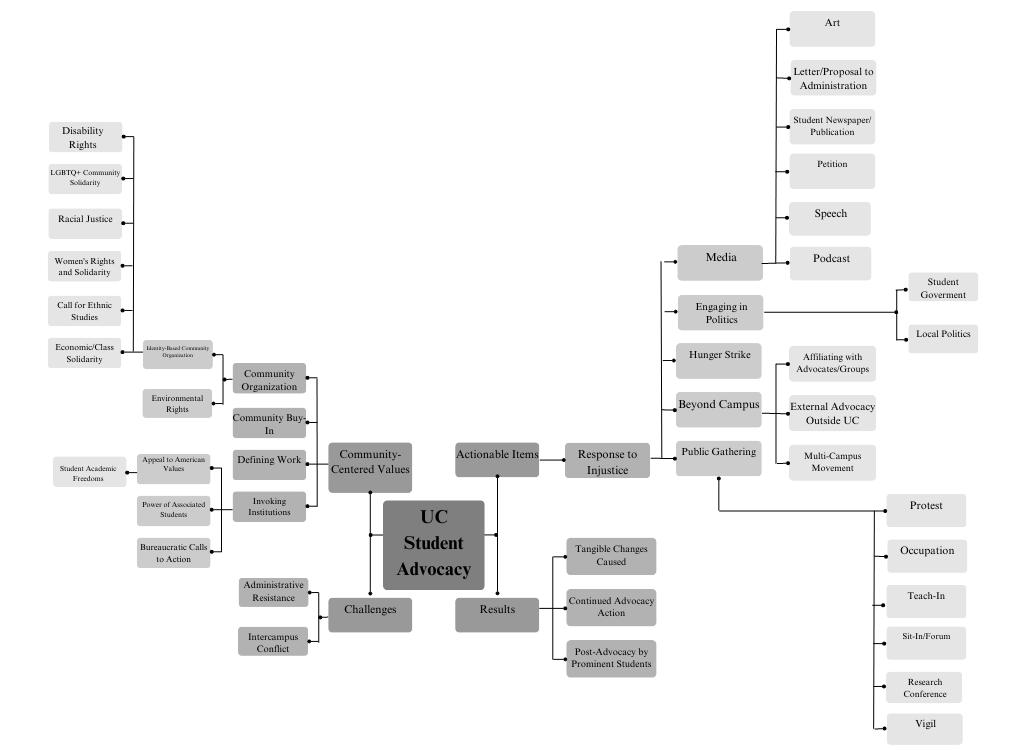
7.2 Appendix B: Graphs
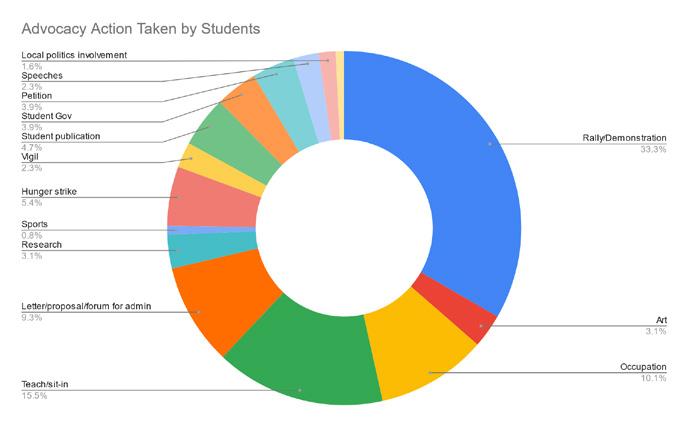
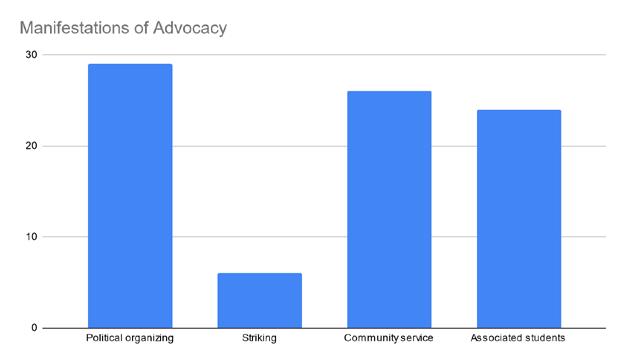

Undergraduate Student Advocacy in the University of California System: Research
Graph B4. Survey Results: “What has been the most significant challenge you have experienced as a student advocate?”
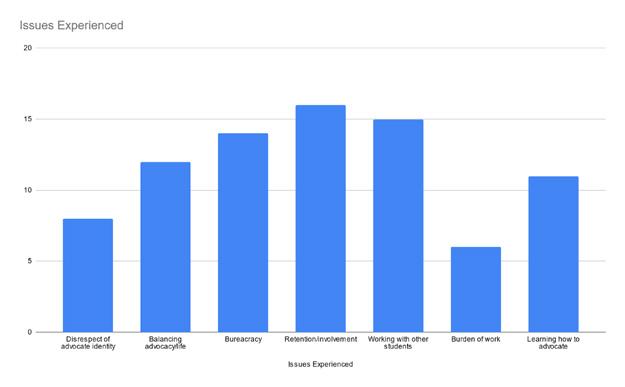
Graph B5. Survey Results: “Do you actively recruit others to participate in your advocacy efforts?”
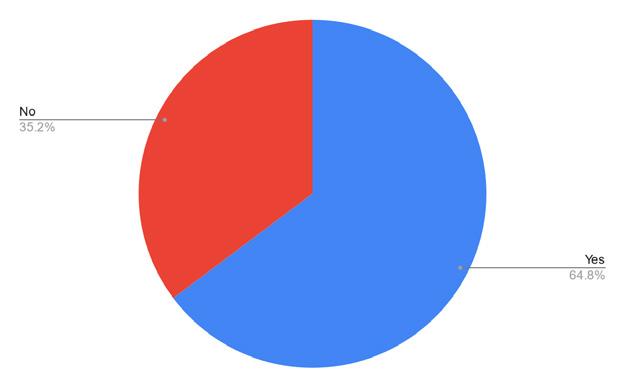
Graph B6. Survey Results: “If yes (you actively recruit others to participate in your advocacy efforts), how do you recruit?”
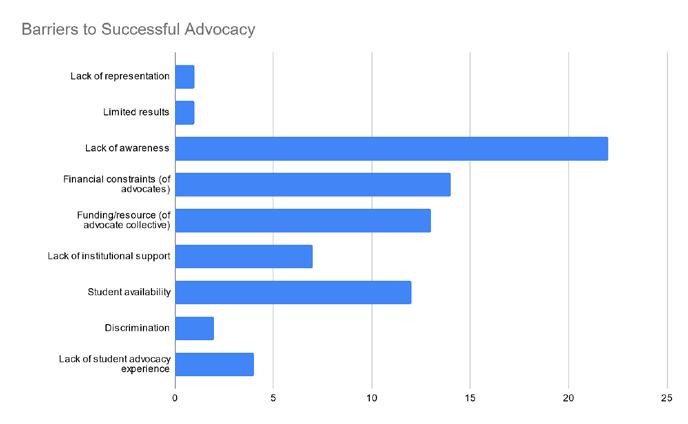
Graph B7. Survey Results: “What do you think prevents students from joining your advocacy efforts?”
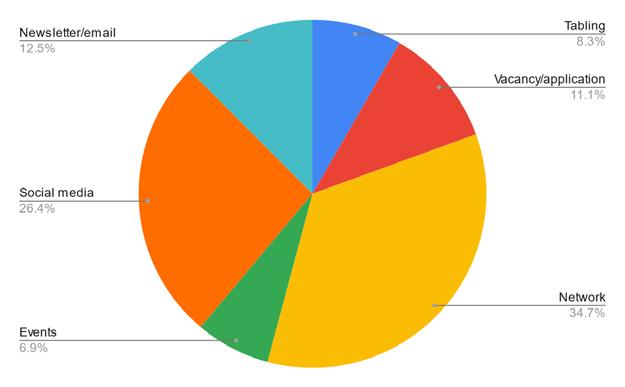
Undergraduate Student Advocacy in the University of California System: Research
Graph B8. Survey Results: “What are the most significant barriers to advocacy that you have experienced?”
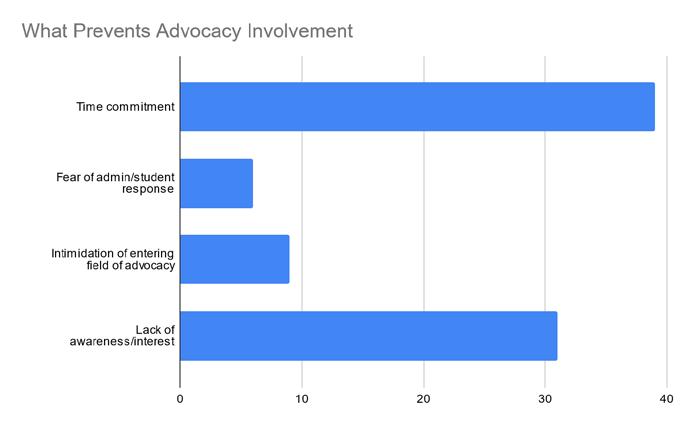
Graph B9. Survey Results: “Do you feel that your identity and demographic background (race/ethnicity, gender identity, sexuality, etc.) has hindered or helped your advocacy efforts?”
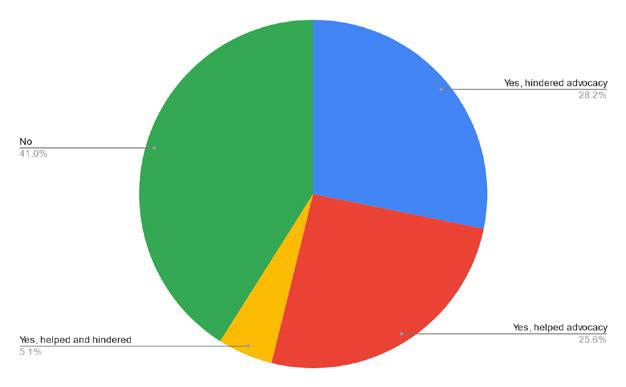
B10. Survey Response:
“Which populations do you think can assist you the most in your advocacy efforts with their support on your campus? Select all that apply.”

Undergraduate Student Advocacy in the University of California System: Research
7.3 Appendix C: Survey Materials
Title of study: Undergraduate Student Advocacy in the University of California System
Investigator: Emma Tolliver
Introduction and Purpose
You are being invited to join a research study.
The purpose of this study is to see if there are barriers to student advocacy for undergraduate students at the University of California campuses.
If you agree to be in this research, you will be asked to complete a questionnaire. You will be asked questions about your experiences as a student advocate attending a University of California campus. It will take about 30 minutes to complete the questionnaire.
There is no direct benefit to you from taking part in this study. We hope that the research will help address the barriers to student advocacy and civic engagement.
The risks of this research are minimal. Some of the questions might make you feel uncomfortable or upset. You do not have to answer any of the questions you do not want to answer.
Confidentiality
As with all research, there is a chance that confidentiality could be compromised; however, we are taking precautions to minimize this risk. Your responses to the survey will include information that identifies you. This identifiable information will be handled as confidentially as possible. However, individuals from UC Davis who oversee research may access your data during audits or other monitoring activities.
To minimize the risks of breach of confidentiality, we will use encrypted and password-protected storage; study records access will be limited to the principal investigator.
The data we collect with your identifiable information (e.g., your name, medical record number, or date of birth) as a part of this study may be used to answer other research questions or may be shared with other investigators for other research. If we do so, we will remove all identifiable information before use or sharing. Once identifiers have been removed, we will not ask your consent for the use or sharing of your data in other research.
Compensation
To thank you for your participation in this study, you will receive a $5 dollar gift card of Amazon credit emailed to you within 7 days after you complete the questionnaire if you are one of the first fifty (50) students from your campus to complete the survey.
Rights
Taking part in research is completely voluntary. You are free to decline to take part in the project. You can decline to answer any questions and you can stop taking part in the project at any time. Whether or not you choose to take part, or answer any question, or stop taking part in the project, there will be no penalty to you or loss of benefits to which you are otherwise entitled.
Questions
If you have any questions about this research, please feel free to contact the investigator at (209) 6008654 or eltolliver@ucdavis.edu.
If you have any questions about your rights or treatment as a research participant in this study, please contact the UC Davis, Institutional Review Board by phone: 916 703 9158 or by email: HSIRBEducation@ucdavis.edu.
If you agree to take part in the research, please click on the “Accept” button below.
Q1. What is your name? This information will be removed from your survey answers and will only be used to ensure you are provided compensation.
Q2. What is your UC email? This information will be removed from your survey answers and will only be used to ensure you are provided compensation.
Q3. Briefly describe your experiences as a student advocate.
Q4. What has been the most significant challenge you have experienced as a student advocate?
Q5. Do you actively recruit others to participate in your advocacy efforts? If yes, how do you recruit?
Q6. What do you think prevents students from joining your advocacy efforts?
Q7. What are the most significant barriers to advocacy accessibility?


